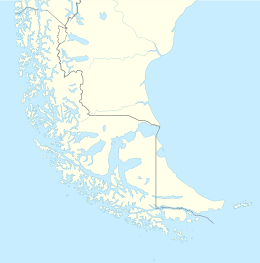 Tierra del Fuego archipelago at the tip of South America | |
| Geography | |
|---|---|
| Location | Pacific Ocean, Atlantic Ocean |
| Major islands | Tierra del Fuego, Hoste, Navarino, Gordon, Wollastone, Noir, Staten, Hermite, Santa Inés, Clarence, Dawson, Capitán Aracena, Londonderry, Picton, Lennox, Nueva, Diego Ramírez, O'Brien, and Desolación Islands among many others |
| Highest point | Monte Shipton |
| Administration | |
| Region | |
| Provinces | Tierra del Fuego Province and Antártica Chilena |
| Communes | Cabo de Hornos, Antártica, Porvenir, Primavera, Timaukel |
| Province | |
| Demographics | |
| Population | >135,000 (2010) |
| Ethnic groups | Argentines, Chileans, Selk'nams, Kawésqar, Yaghans |
Tierra del Fuego (/tiˈɛərə dɛl ˈfweɪɡoʊ/, Spanish: [ˈtjera ðel ˈfweɣo]; Spanish for "Land of Fire", rarely also Fireland in English) is an archipelago off the southernmost tip of the South American mainland, across the Strait of Magellan.
The archipelago consists of the main island, Isla Grande de Tierra del Fuego, with an area of 48,100 km2 (18,572 sq mi), and a group of many islands, including Cape Horn and Diego Ramírez Islands. Tierra del Fuego is divided between Argentina, which controls the eastern part of the main island and a few small islands in the Beagle Channel, and Chile, which controls the remaining land area. The southernmost extent of the archipelago is just north of latitude 56°S.
The earliest known human settlement in Tierra del Fuego dates to approximately 8,000 BC.[1] Europeans first explored the islands during Ferdinand Magellan's expedition of 1520. Tierra del Fuego and similar namings stem from sightings of the many bonfires that the natives built.
Settlement by those of European descent and the displacement of the native populations did not begin until the second half of the nineteenth century, at the height of the Patagonian sheep farming boom and of the local gold rush.[2] Today, petroleum extraction dominates economic activity in the north of Tierra del Fuego, while tourism, manufacturing, and Antarctic logistics are important in the south.
- ^ Morello, Flavia; Borrero, Luis; Massone, Mauricio; Stern, Charles; García-Herbst, Arleen; McCulloch, Robert; Arroyo-Kalin, Manuel; Calás, Elisa; Torres, Jimena; Prieto, Alfredo; Martinez, Ismael; Bahamonde, Gabriel; Cárdenas, Pedro (1 March 2012). "Hunter-gatherers, biogeographic barriers and the development of human settlement in Tierra del Fuego". Antiquity. 86 (331): 71–87. doi:10.1017/S0003598X00062463. hdl:1893/3664. S2CID 161882222.
- ^ Iparraguirre, Sylvia (19 March 2024). Tierra del fuego: a biography of the end of the world. Photo Design Ediciones - Florian von der Fecht. p. 146. ISBN 978-987-99166-9-8. Archived from the original on 23 September 2023. Retrieved 1 March 2016.
